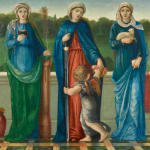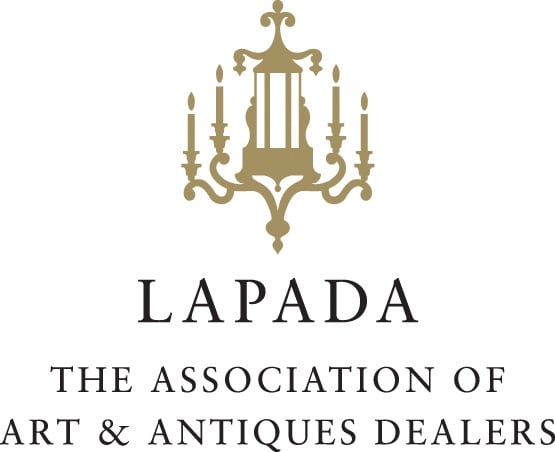Edward Burne-Jones 1833-1898
Framed: 95 x 96 cm.; 37½ x 37¾ in.
Within the reflective silence of Burne-Jones’ St. Barbara, St. Dorothy, and St. Agnes, three martyred saints rise from the artist’s most turbulent personal crisis to become powerful symbols of virtue victorious. Painted in 1869 during his passionate affair with model Maria Zambaco, this remarkable canvas paradoxically serves as an intimate tribute to his wife Georgiana, whose steadfast devotion endured her husband’s emotional infidelities. The work moves beyond religious iconography to become a psychological depiction of feminine strength, created with the otherworldly intensity that characterises Burne-Jones’ most notable achievements.
Three female martyrs stand on gleaming marble before a pastoral landscape. The pure white balustrade creates a symbolic boundary between earthly and celestial realms, while the polished floor reflects azure draperies in pools of light that heighten the painting’s ethereal atmosphere. Each figure occupies a distinct space yet participates in unified visual harmony, showcasing Burne-Jones’ mastery of Renaissance compositional principles. St Barbara, positioned on the left, gazes outward with deep introspection. Draped in flowing blue beneath a green mantle, she embodies scholarly devotion, clutching a volume that signifies religious learning, while beside her rises the cylindrical tower that has become both sanctuary and prison. The structure’s barely visible three windows symbolise her devotion to the Trinity, the revelation that led to her martyrdom. Her peacock feather, enigmatic yet possibly alluding to resurrection, completes her iconographic identity whilst suggesting the transcendence of earthly vanity through faith.
The central figure, St Dorothy, was a 2nd Century maiden of Caesarea in Cappodocia, put to death by sword by the Emperor Diocletian for refusing to marry on the grounds that she was mystically espoused to Christ. An angel stands before her carrying a basket of roses, the miraculous flowers Dorothy promised to send from heaven’s garden to the mocking Roman notary, Theophilus, leading to his own conversion. Dorothy’s red undergown, visible beneath her blue mantle, provides the painting’s most striking colour contrast, while symbolically referencing both royal lineage and the blood of martyrdom.
St Agnes adorns the right side – another victim of Diocletian’s suppression martyred in Rome in 304AD. Her cascade of hair references the miracle of her execution, when her tresses grew to preserve her modesty. She gently holds a lamb, both a symbol of her identity and a nod to her name’s Latin origin, with protective tenderness. Yet, her expression displays unwavering faith upheld through persecution. She is a symbol of sacrificial innocence, linking Agnes to Christianity’s broader story of redemption.
The biographical subtext of the painting is unavoidable. In 1869, Burne-Jones’s involvement with Maria Zambaco reached a crisis when she attempted suicide with laudanum, forcing him to confront the destructive potential of his romantic obsessions. The three saints, with their shared dedication to virginal purity and rejection of earthly marriage, serve as stark contrasts to the sensual Venus archetype that Maria embodied. More importantly, all three martyrs clearly resemble Georgiana Burne-Jones, whose quiet strength and moral authority supported both her husband’s career and their troubled marriage. Her Methodist upbringing, emphasising moral integrity and spiritual discipline, is perfectly reflected in these figures who chose divine love over earthly passion.
Technically, the work reveals Burne-Jones’ progression from early Pre-Raphaelite linearity to a refined Italian Renaissance synthesis. The drapery modelling reflects Giotto’s Scrovegni frescoes, while the elongated figures echo Botticelli’s elegant style. The background landscape, with its atmospheric perspective and rolling hills, evokes Giovanni Bellini’s sacra conversazione, creating infinite depth beyond architectural boundaries.
The work’s origins lie in designs for All Saints Church, Cambridge, linking it to Victorian church decoration and the Gothic Revival movement. William Morris was commissioned to create the East Window in 1866 and turned to Burne-Jones to produce 15 cartoons, which included individual portrayals of St. Barbara, St. Dorothy and St. Agnes. Uniting these figures into the present painting, it was purchased shortly after by Burne-Jones’ greatest patron, William Graham (1817-1885). Graham, whose collection included the artist’s finest works, recognised a union of technical skill and emotional depth that ranked it among Pre-Raphaelitism’s most notable achievements. The painting connects the movement’s early medievalism with the aesthetic sophistication that would influence later Symbolist artists. Its blend of narrative clarity, technical skill, and psychological depth makes it a major achievement in Victorian religious art.
Provenance
Purchased from the artist by William Graham in 1869 (listed as no.15 in his 1882 inventory);
Sold by the beneficiaries of William Graham, Christie’s, London, 3 April 1886, lot 156 to Sir John Gray Hill of Mere Hall, Birkenhead with whom it remained until 1911;
His sale, Christie’s, London, 11 February 1911, lot 119 to Gooden & Fox, London;
Sotheby's, London, 18 March 1964, lot 138;
Maas Gallery, London;
Agnew’s, London; Lord Lambton by 1971;
Private collection, London;
Christie’s, London, 22 November 2006, lot 230
Sotheby's, London, 10 December 2019, lot 15
Private Collection (purchased from the above)
Exhibitions
London, New Gallery, Exhibition of the Works of Sir Edward Burne-Jones, Bart., 1898-9, no.107;
Sheffield, Mappin Art Gallery, Burne-Jones, 1971, no.24
Literature
Fortunee de Lisle, Burne-Jones, 1904, p.182;
Arsene Alexandre, Sir Edward Burne-Jones, 1907, illustrated plate 8 from a photograph by Frederick Hollyer;
Oliver Garnett, ‘The Letters and Collection of William Graham – Pre-Raphaelite Patron and Pre-Raphael Collector’, Walpole Society, Vol.62, 2000, pp.249, 290
Join our mailing list
Be the first to hear about our upcoming exhibitions, events and news
* denotes required fields
We will process the personal data you have supplied to communicate with you in accordance with our Privacy Policy. You can unsubscribe or change your preferences at any time by clicking the link in our emails.




